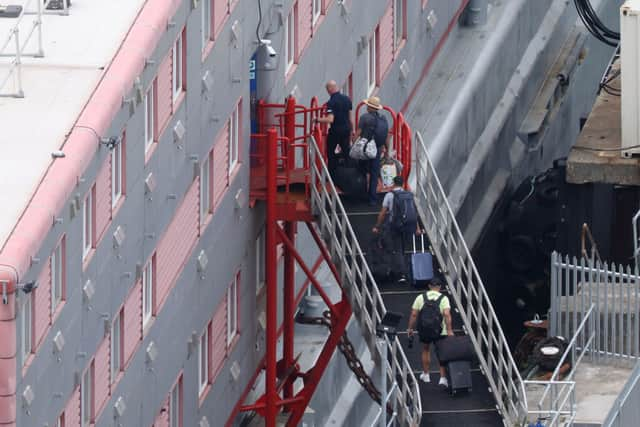UK immigration: how the Home Office should tackle the record-high asylum seeker backlog, according to experts
and live on Freeview channel 276
The backlog of asylum claims in the UK has hit a new record high, according to newly-released Home Office figures.
A total of 175,457 people were waiting for an initial decision on an asylum application in the UK at the end of June 2023, up 44% from 122,213 in June 2022. It is the highest figure since records began in 2010. Meanwhile, the number of asylum seekers waiting more than six months for an initial decision on their claim stood at 139,961 at the end of June, up 57% from last year’s 89,231 - another record high.
Advertisement
Hide AdAdvertisement
Hide AdIt means that the total cost of Home Office spending on asylum seekers in 2022/2023 has reached an eye-watering £3.97 billion - up from £2.12 billion in 2021/22. One decade ago, in 2012/2013, the total spend was £500.20 million.
The Home Office said that the rise in the number of asylum seekers waiting for decisions is “due to more cases entering the system”. In a separate statement, a spokesperson added that slightly more recent data, up to the end of July rather than the end of June, showed that the backlog was now falling. They claimed the government was therefore confident of meeting Rishi Sunak’s pledge to clear the so-called legacy backlog - cases which begun before the end of June 2022 – by the end of 2023.
However, experts and charities have argued that the backlog is a “product of the government’s own making”. Responding to the figures, Refugee Action slammed Prime Minister Sunak and Home Secretary Suella Braverman’s “deterrence” approach to immigration, calling it “unworkable” and urging them to look at “rights-based solutions”.
Refugee Council said the backlog is having a “devastating” impact on asylum seekers - but insisted things could be fixed if ministers adopted a “humane, orderly, and ambitious” approach to reducing processing and decision-making times. But what could be done in practice to tackle the crisis? Here’s what experts on the topic suggested.
Advertisement
Hide AdAdvertisement
Hide Ad

‘Create safe and legal routes’
The majority of experts and charities have long insisted that the creation of safe and legal routes would help the government tackle the asylum seeker process. Currently, the ways for people to reach the UK are “extremely limited”, Refugee Action said, which forces people to turn to “dangerous” small boat crossings.
One possible way of creating more safe and legal routes, Refugee Council recently suggested, would be to create a special new visa for asylum seekers fleeing war and persecution. Under the plan, outlined in the charity’s National Refugee Strategy, people from the top refugee-producing countries - Afghanistan, Iran, Syria, Eritrea, and Sudan - would be able to apply for permission to travel to the UK in order to claim asylum.
To request a visa, applicants would need to leave their home country and then submit an application, either online or at centres which would be set up in neighbouring countries to the ones they are fleeing. This would enable the UK to better process people possibly arriving in the UK - which in turn would help clear the backlog.
According to Refugee Action, another way to in essence create more safe and legal routes to the UK would be if the “better committing to resettlement schemes.”
Advertisement
Hide AdAdvertisement
Hide AdTara Povey, the charity’s policy and research manager, previously explained to NationalWorld: “Obviously, the government tried to set up one for refugees from Afghanistan. But the communication of this was poor - meaning very few people actually got resettled via this route, and tragically, some Afghans still attempted unsafe journeys in desperate attempts to get here”. Improving these sorts of schemes could in turn improve the processing of asylum seeker claims.


‘Streamline the processing of asylum applications’
In the meantime, if the government does not want to set up some of the offshore processing suggested above, an alternative would be to simply “streamline” the current application process, Alice Lucas, Red Cross policy and advocacy manager, previously told NationalWorld.
This would involve creating a faster decision-making process for people from high-grant places - or, as described by Refugee Council, the “top refuge-producing countries”. Lucas explained: “In 2022 for example, a huge proportion of people who came to the UK were from Syria and Eritrea, and 98% of these claims were granted.
“So if you create a faster process for these countries, and leave the more intense processing and decision-making for the more complex cases, you’re already cutting the backlog”.
Advertisement
Hide AdAdvertisement
Hide Ad‘Give those waiting six months for a decision the right to work’
Refugee Action has also urged ministers to give those who have been waiting for more than six months for a decision on their claim - and have therefore essentially been living life in limbo - the “right to work”. Analysis by the charity shows that stopping asylum seekers from working costs the taxpayer over £400 million a year - so allowing them to work would save money which in turn could be used for other things, such as more caseworkers to process decisions.
Also, by allowing asylum seekers to work, more accommodation options could become available - which would reduce the housing pressures currently plaguing the UK’s asylum system.
‘Ban the use of costly and inappropriate, and X accommodation’
Finally, on the topic of accommodation, Refugee Action has also urged the government to “ban the costly and inappropriate use of hotels, barracks, repurposed holiday camps, and reception centres” to house refugees.
There have been plenty of issues with asylum seeker housing in recent months - such as the detection of Legionella bacteria on the Bibby Stockholm barge just days after a group of migrants boarded. This not only endangered those on board, but also resulted in an evacuation operation which placed further pressure on the already-strained system.
Advertisement
Hide AdAdvertisement
Hide AdInstead of these types of accommodation, Refugee Action suggested housing people “in the community” - and insisted upon “working better with local authorities to achieve this.” This could also go hand-in-hand with allowing asylum seekers to look for employment, as this would enable people to contribute to the community.
Comment Guidelines
National World encourages reader discussion on our stories. User feedback, insights and back-and-forth exchanges add a rich layer of context to reporting. Please review our Community Guidelines before commenting.
